https://www.youtube.com/watch?v=MEOLY9D5n2k
How to Grow Squash Vertically...EVEN ZUCCHINI! Small Space Gardening.
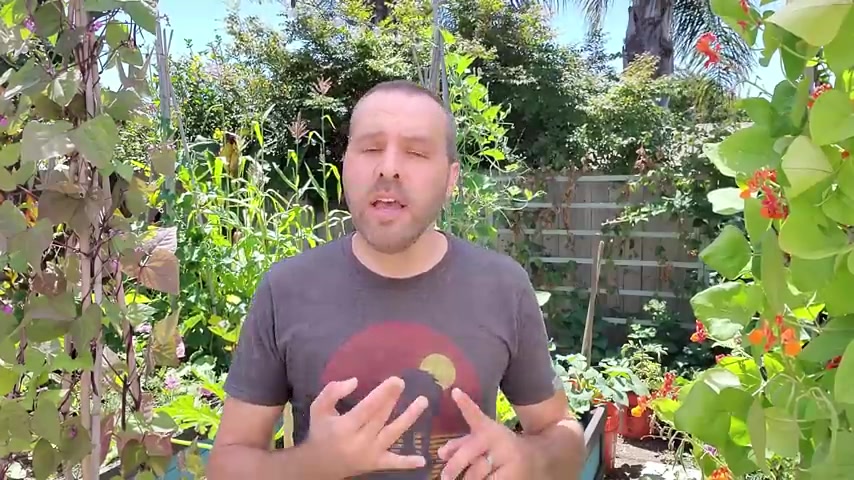
So if you're like me , you might think that in your limited growing space , you don't have room for members of the Korba family , like uh winter and summer squash , melons , pumpkins .
They just take up too much space in this video .
I'm gonna show you how to take these plants a vertical to open up more growing space in your garden .
And it's easier than you think four ways to do it coming up .
Hey guys , I'm Brian with California Garden TV .
And if you're looking to join an online garden community that offers tips , tricks and support to help you grow your best garden ever .
You're in the right place .
Get started now by clicking , subscribe and hit the bell .
So you never miss anything .
Now , let's get growing vertically .
Now , you guys might think that I have more growing space than I actually do because of all the produce I get out of it .
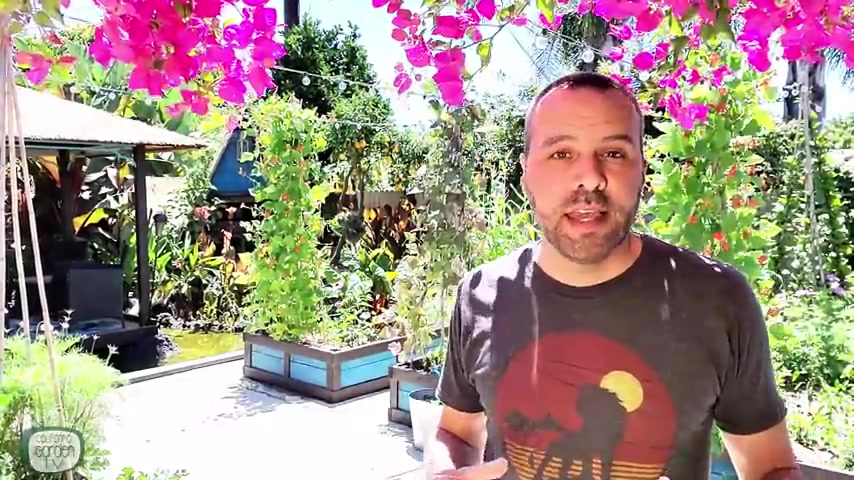
Technically in my backyard raised beds , which is most of my vegetable growing space .
I only have 100 and 70 square feet .
The way I get more production out of this small space is just about every single bed .
Actually , every bed has some sort of vertical element to it .
And that way I have the opportunity to take that 100 and 70 square feet of growing space and multiply that into 1300 cubic feet of growing space .
Now , you guys all know that I grow my tomatoes vertically , right ?
And beans are kind of a no brainer .
But how about things like cucumbers ?
Ok .
How about some winter squashes ?
A little out of the ordinary but nothing too crazy .
How about watermelons and pumpkins ?
Now we're getting weird .
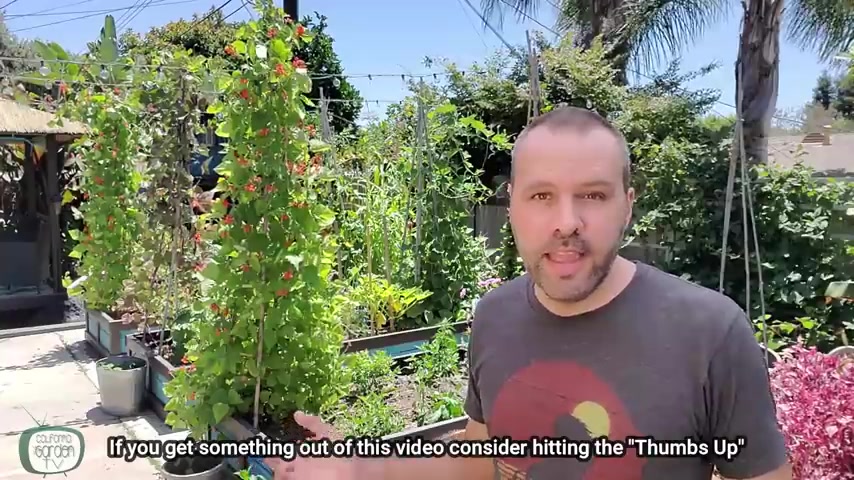
Well , what about summer squash and zucchini ?
That's just crazy talk right now .
The first method is the most prominent in my garden and that is the tepe .
Now , I did a video in the spring about how to make these tepees for free or really cheap .
So go ahead and check that out .
I'll put a link down in the description of the video to that one .
The second way is with a cattle panel or something similar .
These are a metal grid used for fencing .
They're incredibly durable and affordable .
The third way is with the string method like I use for my tomatoes .
The last method involves using a simple wooden steak .
So tepe are great for beans , but they're also great for just about any member of the winter squash and gourd family plants that love to go nuts that like to ramble all over everything .
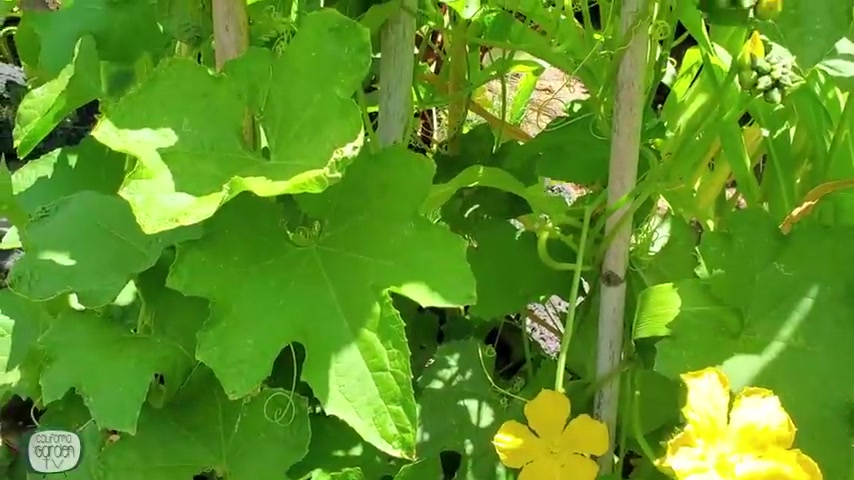
They also generally have small to medium sized fruits that don't need a lot of extra support from the gardener on this one .
I'm growing my Lofa .
It did really well on the tepe last year and I will never grow it any other way over here .
On the other side of the path .
I have my birdhouse gourds on this T P and it's actually taken over this T P and it's working its way into another one that I had for cucumbers and I had no idea how crazy these grew and it smothered out the cucumber and took its T P .
But last year I had cucumbers on tepes as well and they did really great when they didn't have a thug like this next to them .
You can see that this one's loaded with gourds .
One of them is really big already .
Now , I've tried growing medium size pumpkins and melons on the tepes .
The problem with that is sometimes they get a little big and they need some support and you can use like panty hose made into a sling um or mesh bags .
But you have to tie those on somewhere .
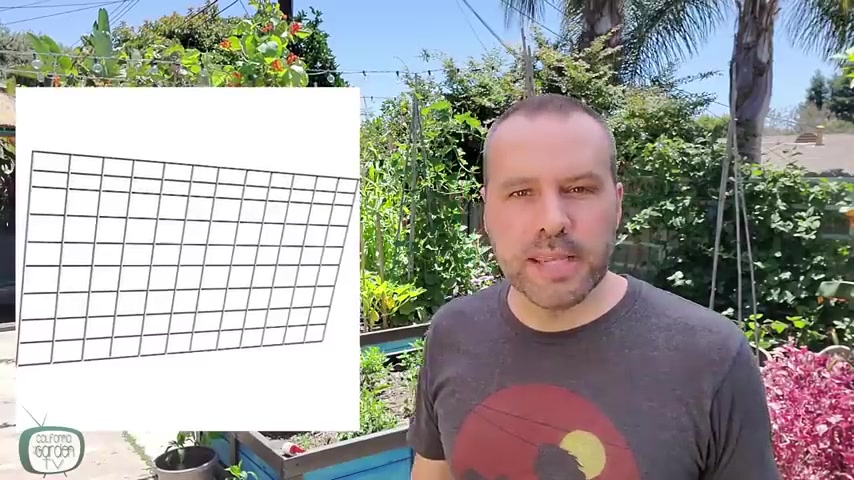
And with the bamboo , you know , they're almost vertical and they're slick and so they kind of just slid right down the , the bamboo cane .
So if you're wanting to grow pumpkins and melons , a better solution for that are cattle panels .
Now , cattle panels are basically a panel fence made of very strong uh metal that lasts for years and years and years Now , I've heard from a lot of you when I did videos on cattle panels before , uh especially in Europe that you can't find those there .
In that case , you can use a wooden lath trellis .
Um It won't last forever , but it will serve the purpose .
Now , in either of those situations , you want to take either rebar or a tea post or two and drive those into the ground and then lash the trellis or the cattle panel to it with zip ties creates a really strong support .
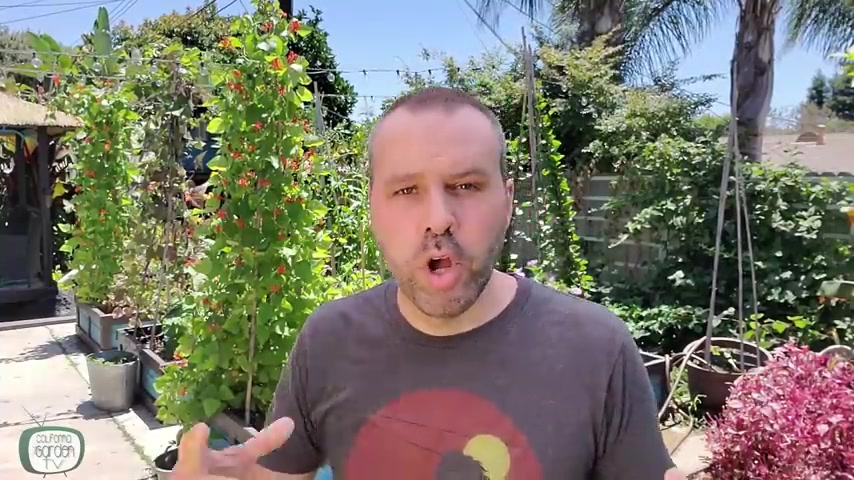
Now , over at Tammy's Garden this year , she is using my cattle panel to grow watermelon , miniature uh sugar baby water and cantaloupe .
The large openings in the cattle panel allow the plant to have lots of room to grow and to climb naturally .
Um You might need a little training in the beginning but they'll , they'll figure it out , but it's got a lot of cross pieces for you to be able to secure any type of sling or support that maybe larger fruits might need .
Now , they're also great for winter squashes like spaghetti squash , butternut squash .
I've grown them on there successfully many times .
If you have a vertical string trellis like I have for my tomatoes , those are perfect for growing cucumbers you can see over here , I've got my Armenian cucumbers , they're all already to the top of the trellis .
But cucumbers were really , really great this way and it's a great way to fit a lot of cucumbers into a very small space .
A lot of times when cucumbers grow along the ground , they get diseased .
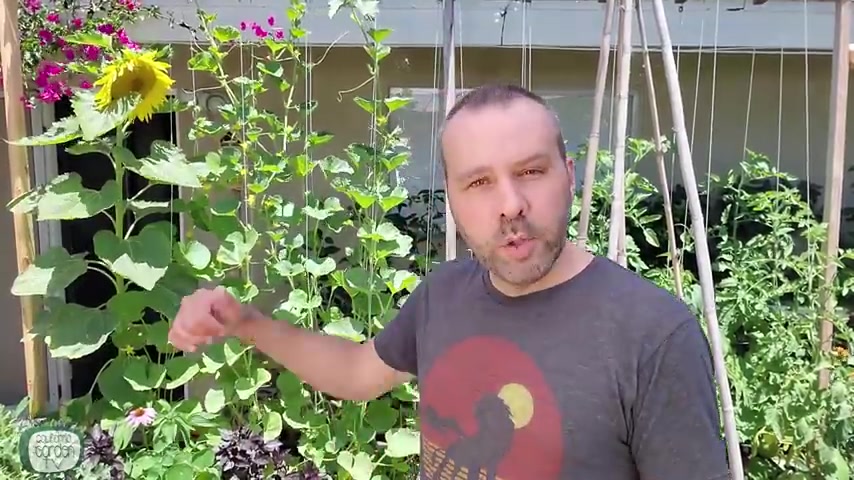
The fruit turn into some weird shapes , maybe discolored and they get nibbled on by pests .
If you grow them up vertically like this , it gives them good air flow .
So the disease process doesn't have a chance to get started in the first place .
Plus you get rid of the misshapen fruit and the pest problems and it's just an all over , better way to grow them .
Now , you do it the same way as the tomatoes landscape staples in the ground , run the string up to the top and then wind the cucumber around the string as it grows , its 10 rolls will also help it climb and hold on .
That's something tomatoes don't have .
And you can also use this method to grow miniature pumpkins or smaller winter squashes .
Now , how about those summer squash , zucchini and yellow ?
My two favorites .
So I thought I invented this method .
I was really proud of myself and then I saw a couple of other people doing it .
Always the case , right ?
Come up with a million dollar brand new idea and realize very quickly that there are very few new ideas .
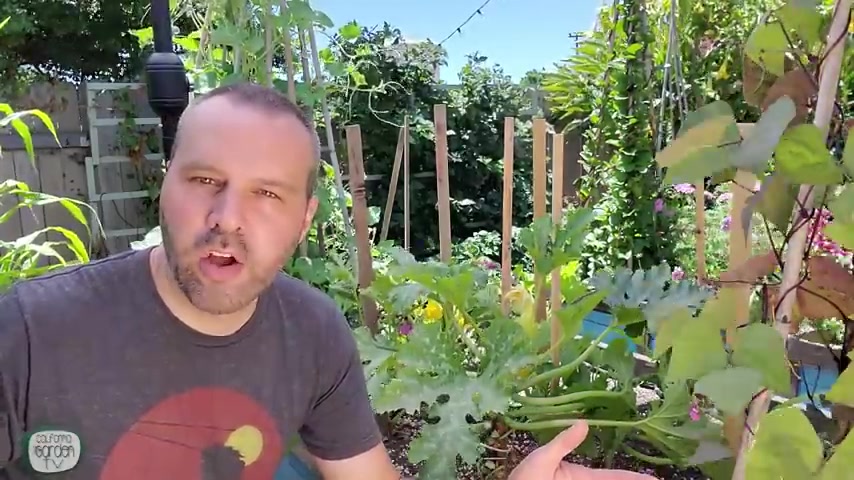
I was always annoyed because summer squashes , they take up so much space , you start out in one spot and then throughout the season , they snake their way through the bed and the trunk is like two ft , 3 ft long and they end up in another space altogether .
And so that's a lot of wasted space in there that you could have had other crops growing in .
So , in the same vein as everything else , I decided to go vertical at planting time , you drive a stake , one or two ft into the ground .
You want it to be pretty sturdy because these do get top heavy when they reach the top of the stake .
And so you don't want them toppling over , plant the plant next to the stake .
And as it grows , just tie the main trunk onto that steak for the lifetime of the plant , it'll get taller and taller and taller .
Now as it grows , the bottom leaves will be , will turn yellow , look old , maybe get mildew disease .
Uh just chop those off .
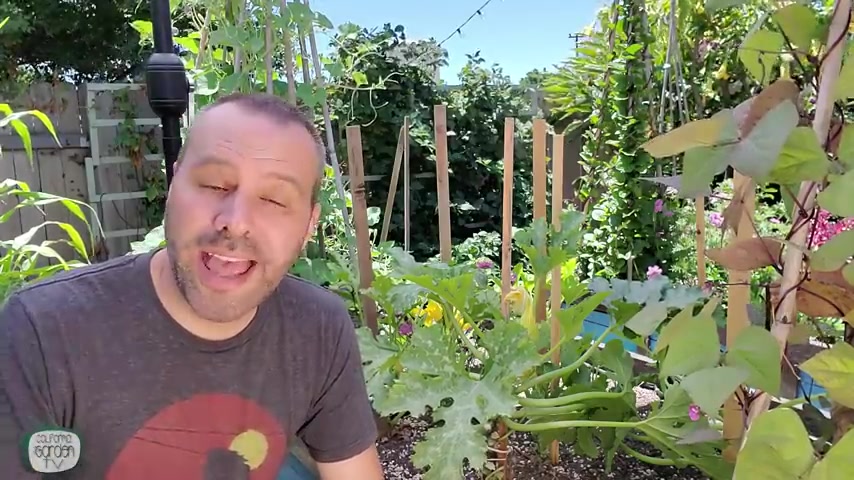
And in the end , you're gonna have a trunk like a tree with a zucchini plant on top and it's going to produce all the way up that trunk the whole season .
So first of all , this saves a ton of space .
Second , you get the fruit up off the ground out of the way of pests that would come along and nibble it .
Third as it grows any way you grow it , you need to take off the old leaves as they get old and , and diseased .
And this makes it really easy to do that .
Fourth , as you can see in this bed , if these were all on the ground .
It would be just kind of a carpet of leaves .
Um , this gets them up off the ground , the air flows right through the plants and it keeps them very close to disease free .
And then the last benefit of this is it gets the flowers and the fruit up off the ground .
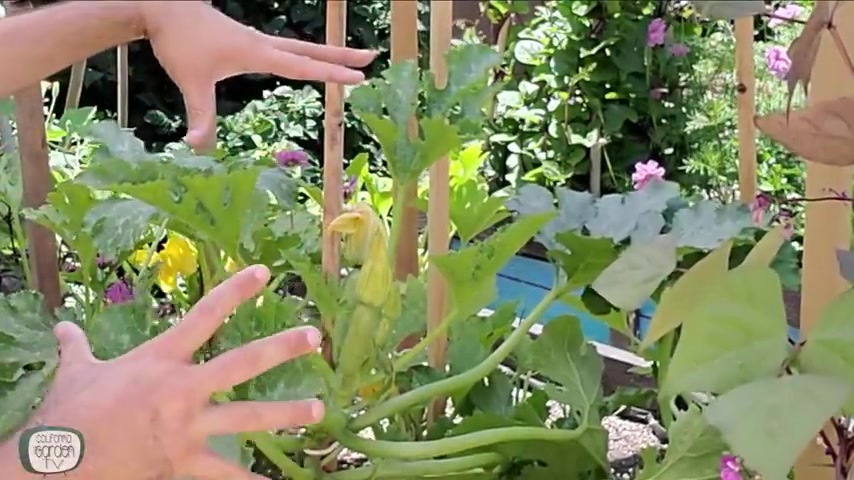
And this way , they're up in the air where the , um , the pollinators are basically , you're bringing them into their eye level because a lot of times you'll see a canopy of leaves in your squash patch and you can't really see the blooms because they're hidden underneath all the leaves .
So as you can see these are prominent and as soon as these open , the bees will be right in there .
Now , chances are you've already started your summer squash and you didn't put a stake in the ground and you hadn't planned on doing this .
But it's a really easy transition , get these little wooden stakes at the garden center or Home Depot and like I said , drive them in two ft but not a foot or two , but not next to the plant at least six inches away from the plant .
And so once that plant , then or if it's already reaching that post , very gently , move it into location and tie it on as low as possible without bending or breaking that main stem and then continue on like you would .
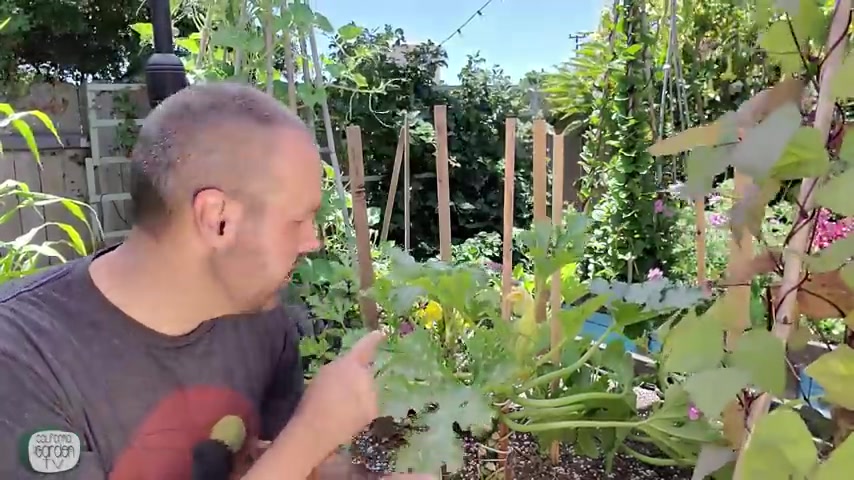
Now , I used to use twine and then elastic , uh , ties to tie these onto the steak .
The only problem with that it works .
But because the ties or the twine is very flimsy .
You find it hard , especially the beginning trying to pull the plant up to the steak and then tie it on because the strings are flopping all over the place .
Now , what I use is this and all this is , is sprinkler conduit , you can get this at Home Depot or even Amazon sells it .
It's the wire you would use for sprinkler systems .
And the reason I like it is because it's very bendable and it's flexible but it stays in place .
So you only need one hand to be able to wrap this around the trunk and the steak and then tie it together .
It's not going to be flopping .
You're not going to be trying , use the twine .
You'll see what I mean .
You'll go for this immediately .
You could also use zip ties .
I think that would work .
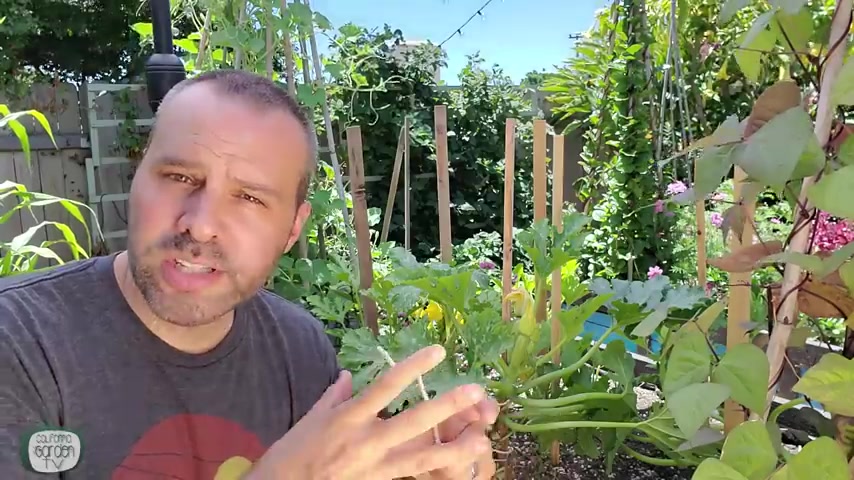
Just don't tighten them up really tight because you need to allow space for that trunk or stem to expand as it grows taller .
But literally , I've been using this for 15 years .
I got a spool of it 15 years ago and I use it over and over and over every year on everything , not just plants .
I found uses for it for everything .
So it's one of those things that you can buy , um , that you can literally will last you a lifetime .
So that's it four different ways to grow every kind of squash vertically .
Let me know in the comments if you're already using one of these methods and how it's working for you , or if you thought of one that's completely different , that maybe no one else has ever used before and let us know that in the comments as well .
And I will see you guys on Tuesday .
Are you looking for a way to reach a wider audience and get more views on your videos?
Our innovative video to text transcribing service can help you do just that.
We provide accurate transcriptions of your videos along with visual content that will help you attract new viewers and keep them engaged. Plus, our data analytics and ad campaign tools can help you monetize your content and maximize your revenue.
Let's partner up and take your video content to the next level!
Contact us today to learn more.